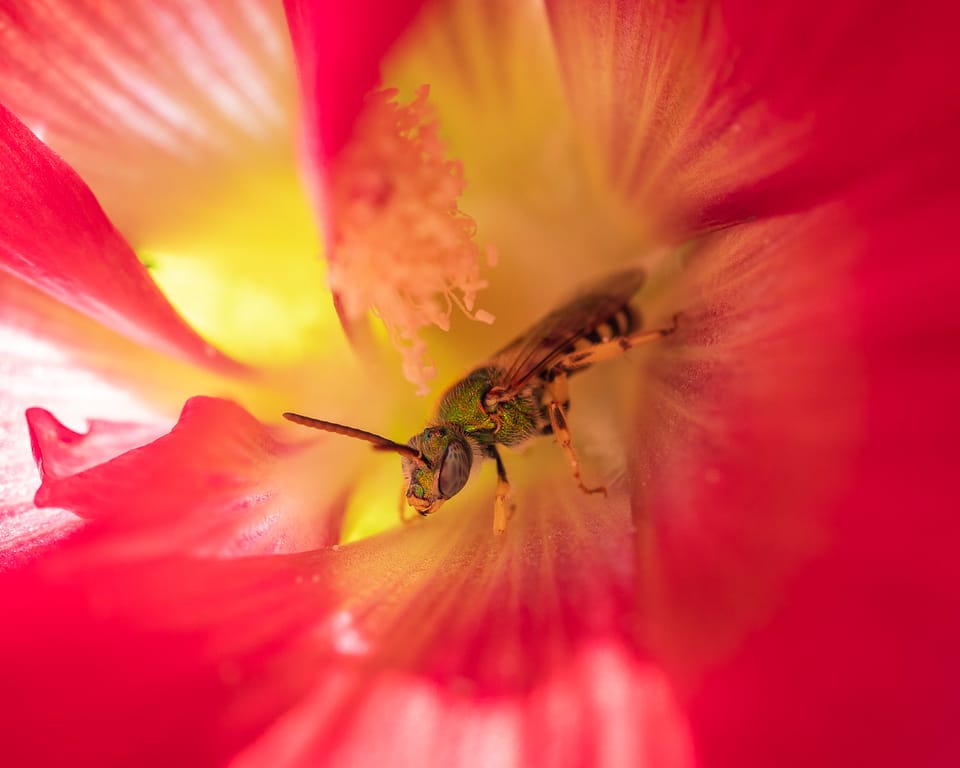Solitary Bees are First-Class Pollinators

Canada’s native bees are first-class pollinators, but they often go unrecognized and unnoticed. Unlike honey bees, most of Canada’s native bees are solitary (bumblebees are the exception). Solitary bees don’t have a queen. Instead, each female bee builds her own nest where she lays her eggs. They don’t produce honey as they don’t have a colony to feed.
Mistaken Identity
Solitary bees aren’t always striped yellow and black like honey bees or bumblebees. Mason and sweat bees are often metallic-coloured, while miner bees are brown to reddish-black with velvety hollows beside their eyes. Leafcutter bees are the same size as honey bees but darker, with a larger head and eyes, and a hairier belly.
Tunnels & Nests
Solitary bees are often hard to spot as they build their nests on the ground or in a tunnel. They have exceptional engineering skills.
Leafcutter bees cut circular pieces of leaves and carry them to a hole to construct a nest. Their nests are often in rotting wood, but they can also be found in snail shells or holes in a concrete wall, in the ground, or in a plant stem. The nests contain several cells, each of which contains a lump of pollen and an egg.
Miner bees dig nest tunnels that are just slightly wider than the bee and can be up to a foot long with several branches. At the end of each branch, the female digs a slightly larger chamber, fills it with food, lays an egg, and seals off the chamber. The eggs hatch into larvae that feed on the supplies left in the nest, emerging in the spring fully grown.
Mason bees nest in crevices (hollow plant stems, empty snail shells, between stones), using mud to build their nests. They will often nest near each other and readily occupy artificial nest sites.
Bumblebees aren’t solitary as they form colonies with one queen and many workers, but they also nest on the ground, either in a mouse nest or other burrow or under a pile of garden debris.
Superior Neighbours
Solitary bees are superior pollinators. Leafcutter bees are used commercially to pollinate alfalfa and blueberry crops and one alfalfa leafcutter bee can do the job of 20 honey bees. Mason bees are most commonly seen in spring and play an important role in pollinating spring-flowering trees and shrubs, including apples, cherries, blueberries, and raspberries. Sweat bees are important pollinators of wildflowers, apples, and stone fruit.
Miner bees make special wing movements while inside a flower to shake loose the pollen on the flower's anthers. Mason and leafcutter bees carry pollen on the hairs on the underside of their abdomen (not their legs) so the abdomen will look yellow when they are carrying a load.
Solitary bees aren’t aggressive. They don’t have a queen or a hive full of honey to protect, and they will die, without having another bee to replace them, if they sting someone. Miner bees have such small stingers that they may not even penetrate human skin.
Bee-Friendly Gardening
We can provide shelter for solitary bees to nest and overwinter by maintaining a “messy” garden. Leave patches of bare, undisturbed ground; leaf litter, brush and rock piles; and dead plant stems. Provide a safe water source (such as a large flat stone with a shallow basin, a puddle, or a plant saucer with a rock in it) and local native plants as sources of food. You may also want to build and install a bee hotel. Avoid weedkillers and pesticides as they harm all pollinators.
You’ll find more information about Western Canada’s bees in Nature Companion, EcoFriendly West’s free app/website introducing many of the plants and animals found in Canada's four western provinces.
Further Information
Solitary Bees and Bee Hotels [Alberta Native Bee Council]
Nesting and Overwintering Habitats [Native Bee Society of British Columbia]
Pollinator Paradise YXE [Wild About Saskatoon]
Will Native Bees Be Outnumbered? [Nature Manitoba]
All About Solitary Bees [Edmonton & Area Land Trust]
How To Support Solitary Bees [Mother Earth News]
So Much We Don’t Know: Alberta’s Native Bees [EcoFriendly West]
Six Unexpected Pollinators [EcoFriendly West]
Photo credit: https://www.flickr.com/photos/apmckinlay/48824329462
EcoFriendly West informs and encourages initiatives that support Western Canada’s natural environment through its online publication and the Nature Companion website/app. Like us on Facebook, follow us on Twitter or Mastodon, or subscribe by email.

Member discussion